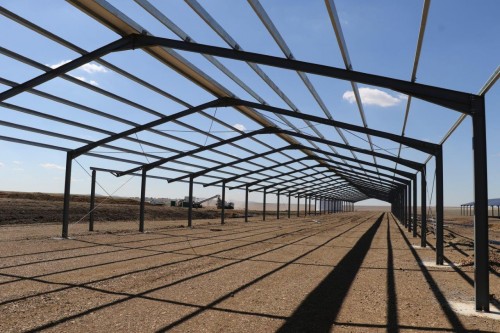Steel is a non-combustible building material that is shock and bending resistant. In practical applications, steel can not only increase the load capacity of buildings, but also meet the needs of architectural design aesthetics.
It also avoids the defects that concrete and other building materials can not be bent and stretched. Therefore, steel is favored by the construction industry. Steels used in single-storey, multi-storey, skyscrapers, factories, warehouses, waiting rooms, and waiting rooms are common.
However, steel as a building material has some inevitable defects in fire protection, and its mechanical properties, such as yield point, tensile strength and elastic modulus, will drop sharply due to the increase in temperature.
Steel structures usually lose their load carrying capacity at temperatures of 450 to 650 ° C, causing large deformations, resulting in bending of steel columns and steel beams. As a result, they cannot be used due to excessive deformation.
Generally unprotected steel structures are fire resistant. The limit is about 15 minutes. The length of this time is also related to the speed at which the component absorbs heat.
In order to overcome the fire prevention deficiencies of steel structural materials in practical applications, fire treatment must be carried out, the purpose of which is to increase the fire endurance of the steel structure to the limits specified by the design specifications.
Preventing steel structures from rapidly heating up in a fire and causing deformation and slumping. The measures are various. The key is to adopt different methods according to different situations, such as using adiabatic and refractory materials to block the flame and directly burn the steel structure to reduce the speed of heat transfer.
Delay the temperature rise of the steel structure and the time when the strength is weakened. But no matter what method is adopted, the principle is the same. The fire protection measures for several different steel structures are described below.
First, the outer layer. It is to add an outer layer on the outer surface of the steel structure, which can be cast in place or sprayed. The cast-in-place solid concrete cladding is usually reinforced with steel mesh or steel to limit shrinkage cracks and to ensure the strength of the casing. The spraying method can apply a sand pump to the surface of the steel structure at the construction site to form a protective layer.
The sand pump can be lime cement or gypsum mortar, or can be mixed with perlite or asbestos. At the same time, the outer cladding layer can also be made of perlite, asbestos, gypsum or asbestos cement, light concrete, and fixed on the steel structure with adhesive, nails and bolts.
Second, water (water jacket). Water filling in the hollow steel structure is the most effective protection against fire. This method enables the steel structure to maintain a lower temperature in the fire, and the water circulates within the steel structure, absorbing the heat of the material itself. The heated water can be recirculated after cooling, or cold water can be introduced from the pipeline to replace the heated water.
Third, shielding. The steel structure is placed in the wall or ceiling of the refractory material, or the component is hidden in the space between the two walls, and the fireproofing purpose can be achieved by adding a little refractory material or increasing it. This is the most economical way to fire.
Fourth, the expansion material. The steel structure fireproof coating protection member adopts the advantages of good fireproof and heat insulation performance, construction is not restricted by the geometric shape of the steel structure, and generally does not need to add auxiliary facilities, and the coating quality is light, and there is a certain beautiful decorative effect. It belongs to modern advanced fire protection technology measures.
At present, high-rise steel structures are increasing, especially for some super-tall buildings, which are made of steel materials. In the event of a fire accident in a high-rise building, the fire will not be extinguished in a short period of time.
This requires us to increase the fire protection of the building materials during the design of the building to enhance its fire resistance and to develop the necessary emergency within the building. Program to reduce casualties and property damage.
Read:The ultimate guide to Flooring in a Printing plant

